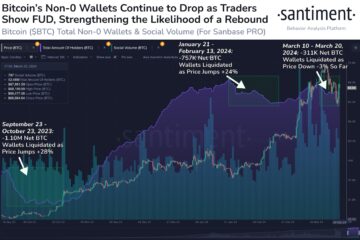The highly anticipated Bitcoin Halving event is close, bringing with it heightened expectations regarding the long-term impact on the Bitcoin price.
There are concerns, however, that this quadrennial event may already be priced in, as Bitcoin recently reached an unprecedented all-time high of $73,700 on March 14.
This surge broke the pattern of previous Halvings, where Bitcoin had never surpassed its previous ATH before the event. However, historical data reveals significant price increases in the year following previous Halvings.
Experts Predict Delayed Bitcoin Halving Price Impact
Analysts argue that the compounding impact of reduced issuance takes several months to materialize, suggesting that the Halving itself may not prompt a significant rally before or immediately after the event.
Deutsche Bank analysts share this sentiment, highlighting that substantial price increases have typically occurred in the run-up to previous Halvings rather than immediately after them.
Another factor to consider is the increased production costs for Bitcoin miners resulting from the Halving. As the mining reward decreases, participating in the mining process becomes less profitable.
This has historically led to a decline in the hashrate, the total computational power used for Bitcoin mining. JPMorgan analysts predict that production costs could rise to an average of $42,000 after the Halving.
One JPMorgan analyst wrote, “This estimate is also the level we envisage Bitcoin prices drifting towards once Bitcoin-Halving-induced euphoria subsides after April.”
While these factors may influence short-term price movement, historical data reveals that the price of Bitcoin has experienced significant increases in the year following previous Halvings.
The respective price gains for the three previous halvings were 8,760%, 2,570%, and 594%. However, it’s important to note that each successive halving has a diminishing impact on the new supply of Bitcoin.
Mining Industry Shake-Up
In the mining sector, Halving could lead to significant revenue losses, estimated to be around $10 billion annually.
According to Fortune, publicly traded miners have taken measures to increase their resilience, diversify their offerings, and optimize their operations. However, mining stocks have faced challenges, with some experiencing significant declines.
While larger miners may undergo a period of adjustment, smaller miners and pools may be pushed offline. This could result in a wider market share for the surviving miners.
Experts at private asset management firm Bernstein expect the mining industry to consolidate, with “smaller and less efficient players” potentially selling assets to raise capital and shore up their balance sheets.
The increased market dominance of the surviving miners is expected to be profitable over the long term, especially with the continued structural demand for Bitcoin from ETFs.
Timing The Bitcoin Bull Market Peak
Cryptocurrency analyst Rekt Capital has provided insights into the potential timing of Bitcoin’s bull market peak based on historical Halving cycles and the current acceleration seen in the market.
According to Rekt Capital, Bitcoin has traditionally reached its peak in the bull market approximately 518-546 days after the Halving event.
However, the current cycle has shown signs of unprecedented acceleration, with Bitcoin surpassing previous all-time highs roughly 260 days ahead of historical norms. Nonetheless, the recent “pre-Halving retrace” has slowed down the cycle by around 30 days and counting.
Taking into account this accelerated perspective, if Bitcoin’s bull market peak is measured from the moment it breaks its old all-time high, it may occur 266-315 days later. As Bitcoin achieved new all-time highs in March, this suggests a potential bull market peak in December 2024 or February 2025, according to Rekt’s analysis.
Both perspectives carry significance throughout the cycle, especially if the acceleration trend persists. However, prolonged retracements or consolidation periods can slow down the cycle, potentially pushing the anticipated bull market peak further into the future.
At the time of writing, BTC was trading at $64,300, up from the $59,000 mark reached in the early hours of Friday.
Featured image from Shutterstock, chart from TradingView.com
Disclaimer: The article is provided for educational purposes only. It does not represent the opinions of NewsBTC on whether to buy, sell or hold any investments and naturally investing carries risks. You are advised to conduct your own research before making any investment decisions. Use information provided on this website entirely at your own risk.
 Bitcoin
Bitcoin  Ethereum
Ethereum  Tether
Tether  XRP
XRP  USDC
USDC  TRON
TRON  Lido Staked Ether
Lido Staked Ether  Dogecoin
Dogecoin  Figure Heloc
Figure Heloc  Cardano
Cardano  WhiteBIT Coin
WhiteBIT Coin  Bitcoin Cash
Bitcoin Cash  Wrapped stETH
Wrapped stETH  Wrapped Bitcoin
Wrapped Bitcoin  USDS
USDS  Wrapped eETH
Wrapped eETH  Monero
Monero  Binance Bridged USDT (BNB Smart Chain)
Binance Bridged USDT (BNB Smart Chain)  Chainlink
Chainlink  LEO Token
LEO Token  WETH
WETH  Zcash
Zcash  Stellar
Stellar  Hyperliquid
Hyperliquid  Coinbase Wrapped BTC
Coinbase Wrapped BTC  Ethena USDe
Ethena USDe  Litecoin
Litecoin  Sui
Sui  Avalanche
Avalanche  Hedera
Hedera  sUSDS
sUSDS  Shiba Inu
Shiba Inu  USDT0
USDT0  Dai
Dai  Uniswap
Uniswap  PayPal USD
PayPal USD  Mantle
Mantle  Cronos
Cronos  Toncoin
Toncoin  Canton
Canton  World Liberty Financial
World Liberty Financial  Ethena Staked USDe
Ethena Staked USDe  Polkadot
Polkadot  USD1
USD1  Aave
Aave  Rain
Rain  Bitget Token
Bitget Token  MemeCore
MemeCore 


